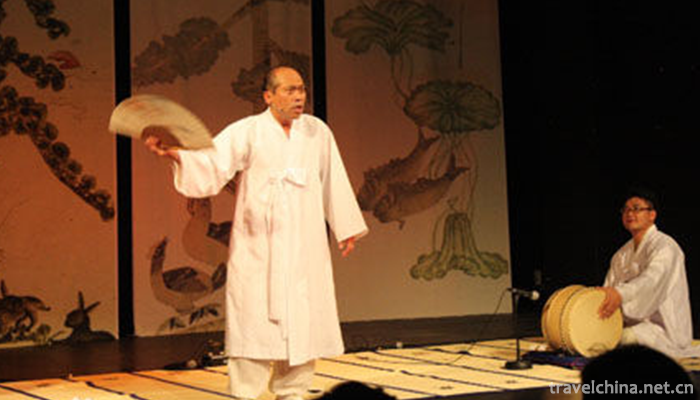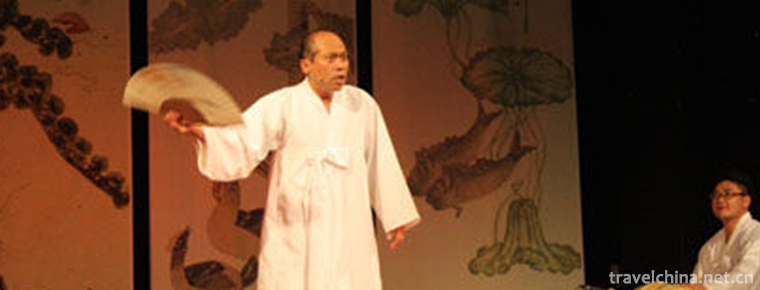Pansori
Pansori
The main art of Korean folk art is Pan Suo Li, which appeared in the 18th century. At the beginning of the 20th century, it was introduced into China with the immigration of Korean nationality. The word Pansori is a literal translation of Korean, meaning a song sung in public. Actors are mainly singing, combining rap and singing. A person can perform large-scale works with complex plots, such as Chun Xiang Zhuan and Shen Qing Zhuan.
On May 23, 2011, Pansori declared by Tieling City, Liaoning Province and Yanbian Korean Autonomous Prefecture, Jilin Province, was listed in the third batch of national intangible cultural heritage list with the approval of the State Council.
historical origin
The origin of Pan Suo Li can be traced back to the period of Suzong (1674-1720) of the Korean Dynasty, which was the period of the rise of Korean civilian culture. It had twelve collections. In the age of Britain and Zhengzu, there appeared "Pan Suoli's Eight Generations of Famous Singers". They expanded the scope of "beat" and "tune". By the end of the Korean Dynasty, Shen Zaixiao had changed the original twelve collections into six collections, which became the Pansori performance we saw today.
artistic characteristics
form
The word Pansori is a transliteration of Korean, meaning a song sung before the public. During the performance, one sits with drums and one stands with rap. In rap and singing, singing is the main method, combining rap and singing. Pansori is good at narration. Its traditional programs such as "Spring Fragrance Song" and "Shen Qing Song" are complex and have many characters. However, they are vividly portrayed by Pansori artists and deeply loved by the audience.
Pansori has a strong narrative, known as the "singing drama". When performing, "one person stands, one person sits, while the standing person sings, the sitting person is drummed", it is a traditional variety show popular with the Korean people. In addition, gossip is also one of the Korean folk art. This kind of music, which is performed by a single person, without makeup and props, is mostly satirical. The performers use various language skills, through "talking, learning and singing", are funny, humorous and lifelike, and are deeply loved by the masses. The Yanbian Quyi Troupe, founded in 1979, is one of the Korean professional art performing groups. It has created and performed such programs as "Yanbian Drum Book", "Three Old Men", "Yanbian Playing and Singing", "Ramble" and so on. It has strong national and local characteristics.
Music
Pansori's rhythm is unique. The so-called rhythm includes the speed, strength, height and rhythm of the rhythm. The main characteristics of the beat are as follows:
Chen Yang Diao: The slowest rhythm in the sandhi. Middle Molly: The slow 12-beat rhythm in a loose tune, often used for lyric or narrative. Molly in Middle School: faster than Molly in Middle School, often expressing grief or excitement. Molly: The 12-beat rhythm in loose tune is very fast, often used for listing and narrating. Wimmerley: The fastest four-beat rhythm in the loose key is used to express the panic scene.
major schools
Eastern stool system is mainly composed of painful sounds and feather tunes. It has a magnificent voice and a refreshing singing style. It can not see the continuous loudness and restrain the performer's own feelings. He is good at playing "Chibi Song".
The centre of the spread of Xiben system is Guangzhou, Luozhou, Baocheng, Kangjin and other places of Quanluodao. Soft timbre, trailing sound at the end, and good at decorative techniques.
The medium-high system is between the above two schools, and the timbre tends to be Eastern-style.
Representational repertoire
The five existing representative songs are: Chunxiang Song, Shenqing Song, Chibi Song, Shuigong Song and Xingfu Song.
The original twelve collections are: Spring Incense Song, Shen Qing Song, Xingfu Song, Rabbit Tortoise Song, Red Cliff Song, Pheasant's Call Ballad, Hengbiao Song, Yue's Call Ballad, Pei's Call Ballad, Jiangling Plum Blossom Call Ballad, Shu Ying Niang Zi Zhuan and Yongyi's Persistent Call Ballad.
Later, the six collections are: Spring Incense Song, Shen Qing Song, Xingfu Song, Hengxiao Song, Rabbit Tortoise Song and Red Cliff Song (Huarong Road)
Inheritance Significance
Although from the market point of view, Pansori's development is limited and performance opportunities are few, but Pansori's inheritance has far-reaching significance.


-
1.Wuhou Temple in Chengdu
Martial Marquis Memorial Temple,Chegdu city,Sichuan Province
Time 2018-09-29 -
2.Xibaipo Scenic Area Pingshan County Shijiazhuang
Xibaipo is located in the middle of Pingshan County, Shijiazhuang City, Hebei Province, with a total area of 16,440 square meters. It was the seat of the CPC Central Committee
Time 2018-11-24 -
3.Sanxianshan Scenic Area
Sanxianshan Scenic Area is located in the northern end of Penglai City, Shandong Province, along the Yellow Sea. It is adjacent to Baxian Cross-Sea Scenic Area in the west,
Time 2018-12-17 -
4.Kuanguo Museum
The Kuanguo Museum is a special museum built on the site of the Kuanguo Cemetery in the Western Zhou Dynasty, a national key cultural relic protection unit. It covers an area of 100,000 square meters
Time 2019-01-13 -
5.Plaque Custom Hakka Plaque Custom in South Jiangxi
Hakka plaque custom in southern Jiangxi has gradually developed with the migration of northern scholars to southern Jiangxi. Hakka traditional custom in rural areas has been formed
Time 2019-04-04 -
6.Hubei Xiaoqu
Hubei Xiaoqu is one of the traditional operas in Hubei Province. It consists of "Hantan Xiaoqu" and "Tianzhao Xiaoqu". Han Tan Opera, also known as "Hankou Tan Opera" and
Time 2019-05-03 -
7.Huai tune Huai Diao
Huai Diao, also known as Huai Diao, also known as Zhanghe Old Diao, is one of the national intangible cultural heritage.
Time 2019-05-04 -
8.Jinhua Taoism
Jinhua Daoqing is also known as singing news and persuading Shiwen. It is a traditional rap art in Zhejiang Province. It combines with Hangzhou gongshu, Wenzhou drum lyrics, Ningbo
Time 2019-05-06 -
9.King Yalu
King Yalu is the first long Miao heroic epic in history. It is usually chanted at the Miao spiritual ceremony. It is only handed down orally and has no written record. The history of the Miao people's
Time 2019-07-10 -
10.Yao Folk Songs
Yao folk song is a popular Yao folk song in Ruyuan Yao Autonomous County of Shaoguan City. Yao language is called "Saihua handle". It is translated into Chinese to mean "the language th
Time 2019-07-11 -
11.Shihaidong scenic spot
Shihaidong scenic spot is located in Xingwen County in the south of Sichuan Province. Because the stone forest and karst caves in the county are distributed in 17 townships, it is known as "stone sea cave town".
Time 2020-10-16 -
12.Yele Nature Reserve
Yele Nature Reserve is located in Yele Township, north of Mianning County, Sichuan Province, bordering on the south of Shimian County, Ya'an City. It is a provincial nature reserve. It is 70 kilometers away from Mianning County.
Time 2020-10-16